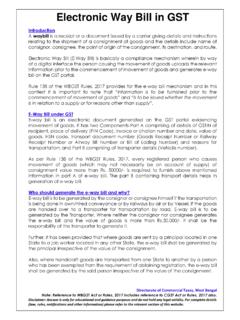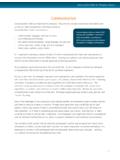Transcription of Bills of Lading vs Sea Waybills, and The Himalaya Clause
1 I:\Courses - 2011\Fed Crt Maritime Law\CD\006B Pamel_Bills of Bills of Lading vs sea waybills , and The Himalaya Clause Peter G. Pamel and Robert C. Wilkins Borden Ladner Gervais, LLP Presented at the NJI/CMLA, Federal Court and Federal Court of Appeal Canadian Maritime Law Association Seminar April 15, 2011 Fairmont Ch teau Laurier, Ottawa 1) Introduction Bills of Lading and sea waybills are two of the most common forms of transport document used in contemporary shipping. Their similarities and difference, and respective uses, in such trade should be clearly understood by all who are involved in that activity.
2 In particular the meaning of document of title used in respect of Bills of Lading , and whether sea waybills are or are not also such documents of title, have given rise to much debate, which has now largely been resolved in major shipping nations. Also, the impact on these transport documents of compulsorily applicable liability regimes set out in international carriage of goods by sea conventions is also essential to a proper grasp of the role these documents play in international maritime commerce. It is also interesting to examine how parties other than carriers, shippers and consignees can and do benefit from certain clauses in ocean Bills of Lading and sea waybills which purport to confer on such third parties or classes of them the exemptions from, and limitations of, liability which marine carriers assume in the performance of their functions.
3 This paper will attempt to provide an overview of these issues, with special reference to how they are addressed in Canadian maritime law. 2) Bills of Lading and sea waybills in Modern Shipping Bills of Lading and sea waybills are the two basic documents that attest to the carriage of goods by water, both domestically within Canada and internationally. They have much in common as well as some differences. It is important to understand the basic character of each, as well as the different types of Bills of Lading that exist, and how they are used in contemporary shipping on the oceans of the world.
4 Goods require transport by sea, in most cases, because they have been sold by a seller to a buyer. Often, these two parties are in different countries or in two geographically separated regions of the same country. Often too, where the seller and buyer are strangers and do not trust one another fully, the sale is financed by a documentary credit (letter of credit) issued by the purchaser s bank in his country in favour of the I:\Courses - 2011\Fed Crt Maritime Law\CD\006B Pamel_Bills of 2 seller s bank in his country. It is important to distinguish the contract of sale of the goods, and the possible documentary credit arrangements which may attend that sale, from the contract for the carriage of the goods from the port of loading to the port of discharge or, as is more often the case, from place of receipt of the goods by the carrier to place of delivery.
5 sea waybills and Bills of Lading are documents attesting to the contract of carriage, although they are, of course, closely related to the underlying contract of sale, and, where applicable, to the documentary credit transaction of the banks concerned as well. A) sea waybills The sea waybill is a non-negotiable receipt for the goods loaded aboard the carrying vessel at the port of loading, which also evidences the terms and conditions of the contract of carriage. They are not negotiable documents, nor documents of The sea waybill is described in the s Carriage of Goods by Sea Act 19922 Because the waybill is non-negotiable, banks involved in documentary credit sales, in most cases, do not allow for the use of waybills in such transactions, especially where the cargo concerned is one likely to be sold and resold one or more times while it is in transit.
6 As any document which is not a bill of Lading but (a) is such a receipt for goods as contains or evidences a contract for the carriage of goods by sea; and (b) identifies the person to whom delivery of the goods is to be made by the carrier in accordance with that contract. (subsect. 1(3)). 3 On the other hand, the sea waybill , unlike the bill of Lading , does not have to be tendered by the named consignee or its agent at the port of discharge or place of delivery in order to take possession of the goods there.
7 It suffices if the consignee identifies itself as the party identified as such in the 1 E. Gold, A. Chircop & H. Kindred, Maritime Law (Toronto: Irwin Law, 2003) at 414. For this reason, the sea waybill lends itself well to contemporary international maritime commerce where 2 1992, c. 50. 3 See the Report of the United Nations Conference on Trade and Development (UNCTAD), The Use of Transport Documents in International Trade , UNCTAD/SDTE/TLB/2003/3, dated November 26, 2003.
8 Concerning a survey conducted by UNCTAD with large container operators and several national shipping lines, as well as shippers and their associations, freight forwarders and banks. The survey showed that 88% of respondents had used, issued or required negotiable Bills of Lading . Of these, 70% used such Bills of Lading mainly or exclusively. The main reason given was the security provided by negotiable Bills of Lading under letter of credit transactions. The security of delivery and payment were also cited as reasons for the continuing preference for Bills of Lading .
9 By comparison, only 51% of respondents stated that they used, issued or required sea waybills . Only 23% of respondents used waybills for the majority of transactions and a mere 18% reported that they used waybills for only 10% or less of all transactions. 4 The Rafaela S, [2003] 2 Lloyd s Rep. 113 at 133 ( ), upheld [2005] 1 Lloyd s Rep. 347 ( ); Peer Voss v. APL Co. Pte. Ltd, [2002] 2 Lloyd s Rep. 707, 722: The sea waybill is retained by the shipper and all the consignee need show to take delivery is poof of his identity. It is a receipt, not a document of title.
10 It, unlike a BL, cannot be used as a security to obtain financing. See also the CMI Uniform Rules for sea waybills 1990 at subrule 7(i): The carrier shall deliver the goods to the consignee upon production of proper identification. See also Gold, Chircop & Kindred, Maritime Law, 2003 at 414 and 415, note 28, explaining that no special form of identification is needed but that sometimes presentation of the pro forma invoice is requested. This invoice is not the commercial invoice, but is a price quotation sent by the shipper in advance of the goods to the consignee to enable the latter to obtain an import licence or to arrange financing.







